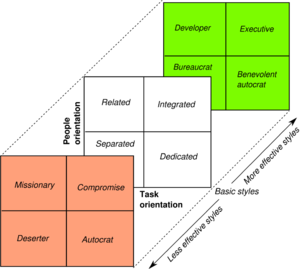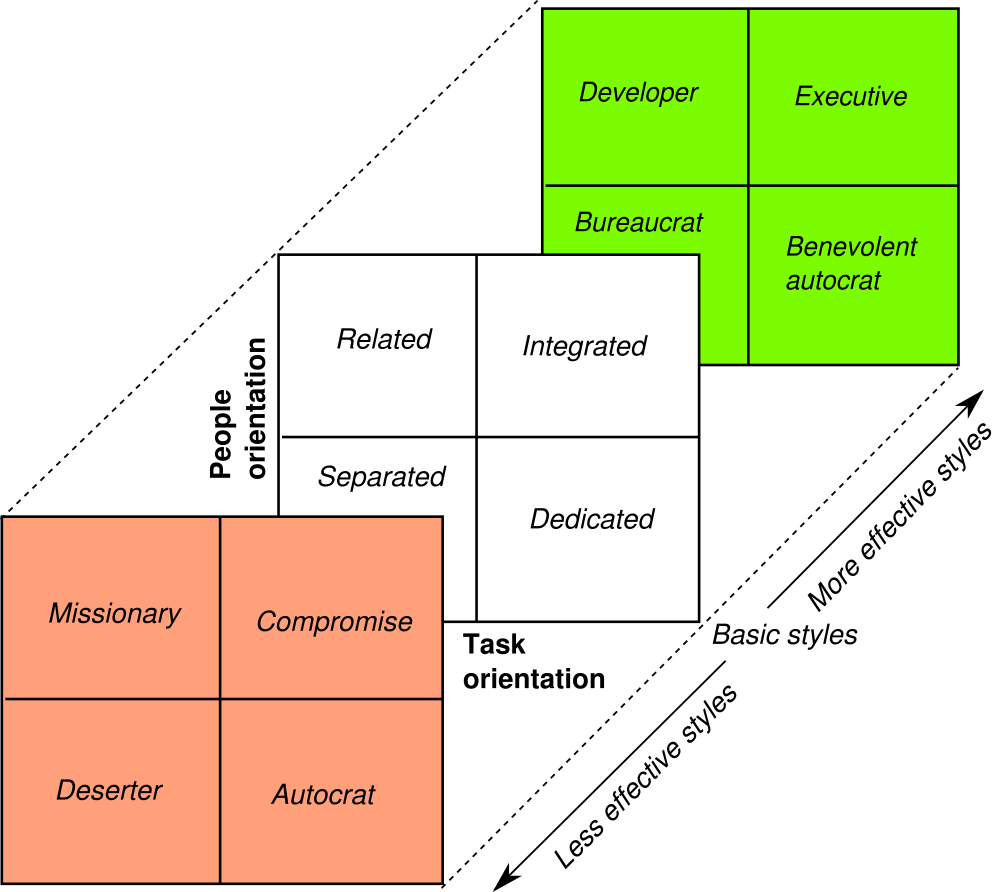Management styles
| Management styles |
|---|
| See also |
Management style can be defined as a relatively permanent and reproducible manner in which the manager affect subordinates in order to stimulate and coordinate their actions in the team, and by this influencing effective achievement of the company's goals. Management style is a concept difficult to define and its essence is expressed as a lifetime relationship that creates a superior managerial influence over the subordinates. Management style is characterized by the overall means (methods, techniques and instruments) that managers use to impact his subordinates in order to induce in them the proper attitude to their jobs and encourage them to their best possible performance.
Potential management style reflect manager's view about what methods he should use to influence his subordinates.
Actual management style is the potential style, which has been corrected under the influence of the current goals and the conditions in which they will have to be pursued.
Research on management styles led to the creation of a variety of concepts, which are often not so much the reality but rather ingenuity of its author.
Management style and McGregor theory X and Y
The starting point for a discussion of management styles (in other words: the behaviour of leaders) is concept developed by D. McGregor called theory X and theory Y.
According to the theory X assumptions, people do not like to work and avoid it as much as possible, they try to avoid responsibility, are not very ambitious and above all want peace and prefer to be directed by others. Under this approach, people should be forced, supervised, controlled and motivated by punishments to compel them to work.
According to the theory Y work is a natural human need, something obvious and inherent for everyone. In the favourable climate of psychological, caused by appropriate methods of management people become very ambitious, creative, and they seek the greatest possible responsibility and autonomy, while engaging in the implementation of the objectives of the organization. They prefer to self-manage and self-control their actions within organization. People are becoming such as the present theory of X under the influence of bad treatment faced in the workplace.

Fig. 1. Employee on continuum between McGregor's theory X and theory Y
In practice, most employees present attitude averaging between X and Y concepts. Thus they can be placed on the imaginary line as presented on fig. 1.
Initially it was thought that the manager should be able to apply specific, best style of management, and there is only one ideal style. Today, it is claimed, rather, that effective manager should have a wider repertoire of leadership styles and should be able to select the most appropriate style for a given situation. Therefore, the role of the manager is to know various management (leadership) styles and their optimal conditions of use.
Lewin, Lippitt and White - two basic styles of management
In this basic typology, they identified certain behaviours in the managers and set following types:
Manager - autocrat:
- Appoints and directs the activities and objectives of both the group and its individual members,
- Assigns each worker area of his operations and co-workers,
- Does not define clear criteria for assessment,
- Does not allow for discussion.
- Commonly uses management by control and management by conflict techniques.
Democratic manager:
- Aims to ensure that the objectives of the organization and its activities is subject of discussion.
- Seeks to provide objective criteria for evaluating.
- Actively listens to his subordinates, he tries to convince them to their position and constructively discusses it.
- During daily management work he can use management by walking around technique.
- Prefers also management by delegation and management by participation.
Managers avoiding interference:
- Plays the role of a friendly, but also passive co-worker
- Gives a lot of freedom to a group of employees
- The question is answered in accordance with the wishes of asking
- Often avoids evaluating members of the group, whether it is a positive assessment or negative
See more at: Lewin, Lippitt and White - basic styles of management
[[wiki.png|
]]
[[wiki.png|]]
Fig. 2. Management styles grid by Robert Blake and Jane Mouton
R. Blake and J.S. Mouton leadership grid
Blake and Mouton built leadership style grid in which the axes (graduated from 1 to 9) describe two factors: the orientation on the task and orientation on the people. On this basis, they have identified five common styles (fig. 2).
- 1.1: - low focus on results and on people,
- 9.1: - very high focus on results, little focus on people,
- 1.9: - very high focus on people, carefree and friendly atmosphere,
- 5.5: - adequate performance at work, a compromise between the results and the rights of co-workers,
- 9.9: - High performance at work, satisfied employees.
See more at: Blake and Mouton managerial grid
R. Tannenbaum i W. Schmidt
They adopted the scale of possible behaviours of the manager, depending on the characteristics of person they direct. Management style is affected by: manager himself, subordinates, situation. Depending on these factors:
- Manager decides and announces it,
- Manager urges employee to accept the decision,
- Manager presents ideas and expects questions
- Manager shows the approximate decisions that may change,
- Manager refers the problem, expects suggestions and decide
- Manager defines the boundaries and proposes the group to decide
- Manager allows the group to make decisions within the boundaries.

Fig. 3. Reddins 3D box of styles of leadership
Third dimension of management styles
In addition to the orientation tasks and people, some researchers have tried to enter the third dimension. P. Hersey i K.H. Blanchard in the evolutionary theory of management adopted as the third dimension the maturity of subordinates determined by their skills and motivation (distinguished following styles: autocratic, inclusive, participatory and delegating).
Later Blanchard in collaboration with Hermes redefined style and singled out: selling, participative, instructing and delegating styles.
In practice, managers adopted W. Reddin model, who as the third dimension distinguished efficiency of manager. He built a three-dimensional graph (expanding concept of management grid by Blake and Mouton), and pointed to twelve styles (fig. 3).
See more at: Reddin's basic management styles
File:Hersey and Blanchard model.png
Fig. 4. Hersey and Blanchard situational leadership model
Hersey and Blanchard situational leadership model
In this model appropriate style for manager, depends on professional maturity of employee. It is determined by two main features: their competencies and motivation (morale). The competences include knowledge or skills. Maturity include motivation and self-confidence in the possibility of achieving the objective (fig. 4.).
Given these two factors 4 levels of maturity can be distinguished:
- M1 - low competence and high morale,
- M2 - medium competences and low commitment,
- M3 - medium / high competence and low commitment,
- M4 - high competence and high commitment.
For each employee's maturity level managers should use different management style. Accordingly, 4 management styles can be distinguished:
- Q1 - instructing,
- Q2 - consulting,
- Q3 - supporting,
- Q4 - delegating.
See more at: Hersey and Blanchard model
Modern management style
The basis of the traditional style was: three C's i.e. commanding, coordination and control, dominated by elements such as authority, for detailed instructions. The new style is based on: participation of employees in management, information, creating a vision, support, consulting and delegating authority and responsibility.
See also:
References
- Blake, R. R., Mouton, J. S., & Bidwell, A. C. (1962). Managerial grid. Advanced Management-Office Executive.
- Hersey, P., & Blanchard, K. H. (1969). Management of organizational behavior (p. 34-5). Englewood Cliffs, NJ: Prentice-Hall.
- Lewin, K., Lippitt, R., & White, R. K. (1939). Patterns of aggressive behavior in experimentally created “social climates”. The Journal of social psychology, 10(2), 269-299.
- McGregor, D. (1960). The human side of enterprise. New York, 21(166.1960).
- Reddin, W. J. (1970). Managerial Effectiveness, McGraw-Hill Book Company, New York
- Tannenbaum, R., & Schmidt, W. H. (1973). How to choose a leadership pattern (p. 3-12). Boston, MA: Harvard Business Review.

